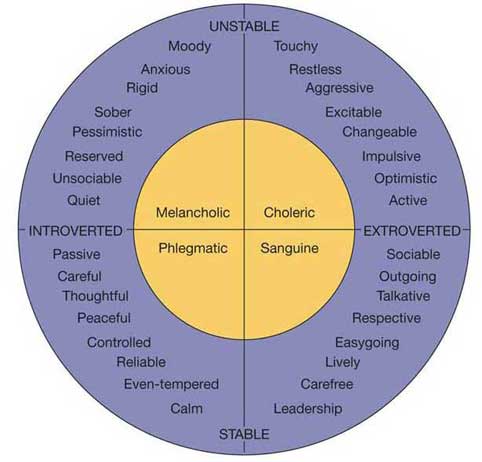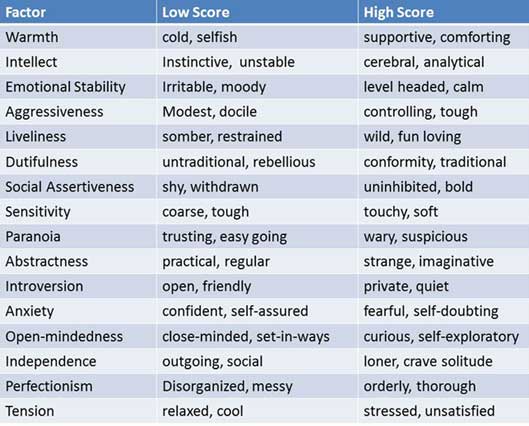On This Page:
Key Takeaways
- Personality tests date back to the 18th century, when phrenology, measuring bumps on the skull, and physiognomy, analyzing a person’s outer appearance, was used to assess personality (Goldstein & Hershen, 2000).
- Beginning in the late 19th century, Sir Francis Galton, a British polymath (an expert in many fields) estimated the number of adjectives in the English dictionary that described personality. Louis Leon Thurstone eventually refined the list to 60 words, and through analyzing roughly 1,300 participants, the list was reduced again to seven common factors (Goldberg, 1993).
- Similarly, British-American psychologist Raymond Cattell developed a Sixteen Personality Factor Questionnaire, a 185 multiple-choice self-report questionnaire used to measure personality in both the clinical and non-clinical settings.
- In the 1980s, after an almost four decade long hiatus, Lewis Goldberg and colleagues (1980) revived Ernest Tupes and Raymond Christal’s (1961) exploration of five major personality traits: openness, conscientiousness, extraversion, agreeableness, and neuroticism (commonly abbreviated as the acronym OCEAN).
- This new model significantly contributed to the wide acceptance and increased popularity the five-factor model received.
What is this thing we call personality? Consider the following definitions, what do they have in common?
“Personality is the dynamic organization within the individual of those psychophysical systems that determine his characteristics behavior and thought” (Allport, 1961, p. 28).
“The characteristics or blend of characteristics that make a person unique” (Weinberg & Gould, 1999).
Both definitions emphasize the uniqueness of the individual and consequently adopt an idiographic view.
The idiographic view assumes that each person has a unique psychological structure and that some traits are possessed by only one person; and that there are times when it is impossible to compare one person with others. It tends to use case studies for information gathering.
The nomothetic view, on the other hand, emphasizes comparability among individuals. This viewpoint sees traits as having the same psychological meaning in everyone.
This approach tends to use self-report personality questions, factor analysis, etc. People differ in their positions along a continuum in the same set of traits.
We must also consider the influence and interaction of nature (biology, genetics, etc.) and nurture (the environment, upbringing) with respect to personality development.
Trait theories of personality imply personality is biologically based, whereas state theories such as Bandura’s (1977) Social Learning Theory emphasize the role of nurture and environmental influence.
Sigmund Freud’s psychodynamic theory of personality assumes there is an interaction between nature (innate instincts) and nurture (parental influences).
Trait Approach to Personality
This approach assumes behavior is determined by relatively stable traits, the fundamental units of one’s personality.
Traits predispose one to act in a certain way, regardless of the situation. This means that traits should remain consistent across situations and over time, but may vary between individuals.
It is presumed that individuals differ in their traits due to genetic differences.
These theories are sometimes referred to as psychometric theories, because of their emphasis on measuring personality by using psychometric tests. Trait scores are continuous (quantitative) variables. A person is given a numeric score to indicate how much of a trait they possess.
Eysenck’s Personality Theory
Eysenck (1952, 1967, 1982) proposed a theory of personality based on biological factors, arguing that individuals inherit a type of nervous system that affects their ability to learn and adapt to the environment.
During the 1940s, Eysenck was working at the Maudsley psychiatric hospital in London. His job was to make an initial assessment of each patient before their mental disorder was diagnosed by a psychiatrist.
Through this position, he compiled a battery of questions about behavior, which he later applied to 700 soldiers who were being treated for neurotic disorders at the hospital (Eysenck (1947).
He found that the soldiers” answers seemed to link naturally with one another, suggesting that there were a number of different personality traits which were being revealed by the soldier’s answers. He called these first-order personality traits
He used a technique called factor analysis. This technique reduces behavior to a number of factors which can be grouped together under separate headings, called dimensions.
Eysenck (1947) found that their behavior could be represented by two dimensions: Introversion / Extroversion (E); Neuroticism / Stability (N). Eysenck called these second-order personality traits.
Each aspect of personality (extraversion, neuroticism, and psychoticism) can be traced back to a different biological cause. Personality is dependent on the balance between the excitation and inhibition process of the autonomic nervous system (ANS).
Extraversion/Introversion
- Extraverts are sociable and crave excitement and change, and thus can become bored easily. They tend to be carefree, optimistic, and impulsive.
- They are more likely to take risks and be thrill seekers. Eysenck argues that this is because they inherit an under aroused nervous system and so seek stimulation to restore the level of optimum stimulation.
- Introverts lie at the other end of this scale, being quiet and reserved. They are already over-aroused and shun sensation and stimulation.
- Introverts are reserved, plan their actions and control their emotions. They tend to be serious, reliable, and pessimistic.

Neuroticism/Stability
A person’s level of neuroticism is determined by the reactivity of their sympathetic nervous system. A stable person’s nervous system will generally be less reactive to stressful situations, remaining calm and level headed.
Someone high in neuroticism on the other hand will be much more unstable, and prone to overreacting to stimuli and may be quick to worry, anger or fear.
They are overly emotional and find it difficult to calm down once upset. Neurotic individuals have an ANS that responds quickly to stress.
Psychoticism/normality
Eysenck (1966) later added a third trait (dimension) called psychoticism, characterized by lacking of empathy, being cruel, being a loner, aggressive and troublesome.
This has been related to high levels of testosterone. The higher the testosterone, the higher the level of psychoticism, with low levels related to more normal balanced behavior.
He was especially interested in the characteristics of people whom he considered to have achieved their potential as individuals.
According to Eysenck, the two dimensions of neuroticism (stable vs. unstable) and introversion-extroversion combine to form a variety of personality characteristics.

Critical Evaluation
Twin studies can be used to see if personality is genetic. However, the findings are conflicting and non-conclusive.
Shields (1976) found that monozygotic (identical) twins were significantly more alike on the Introvert – Extrovert (E) and Psychoticism (P) dimensions than dizygotic (non-identical) twins.
Loehlin, Willerman, and Horn (1988) found that only 50% of the variations of scores on personality dimensions are due to inherited traits. This suggests that social factors are also important.
One good element of Eysenck’s theory is that it takes into account both nature and nurture. Eysenck’s theory argues strongly that biological predispositions towards certain personality traits combined with conditioning and socialization during childhood in order to create our personality.
This interactionist approach may, therefore, be much more valid than either a biological or environmental theory alone.
It also links nicely with the diathesis-stress model of behavior which argues for a biological predisposition combined with an environmental trigger for a particular behavior.
Eysenck Personality Inventory (EPI)
Cattell’s 16PF Trait Theory
Raymond Cattell (1965) disagreed with Eysenck’s view that personality can be understood by looking at only two or three dimensions of behavior.
Instead, he argued that that is was necessary to look at a much larger number of traits in order to get a complete picture of someone’s personality.
Whereas Eysenck based his theory based on the responses of hospitalized servicemen, Cattell collected data from a range of people through three different sources of data.
- L-data – this is life record data such as school grades, absence from work, etc.
- Q-data – this was a questionnaire designed to rate an individual’s personality (known as the 16PF).
- T-data – this is data from objective tests designed to “tap” into a personality construct.
Cattell analyzed the T-data and Q-data using a mathematical technique called factor analysis to look at which types of behavior tended to be grouped together in the same people. He identified 16 personality traits (factors) common to all people.
Cattell made a distinction between source and surface traits. Surface traits are very obvious and can be easily identified by other people, whereas source traits are less visible to other people and appear to underlie several different aspects of behavior.
Cattell regarded source traits are more important in describing personality than surface traits.

Cattell produced a personality test similar to the EPI that measured each of the
sixteen traits. The 16PF (16 Personality Factors Test) has 160 questions in total, ten questions relating to each personality factor.
Allport’s Trait Theory
Gordon Allport’s theory of personality emphasizes the uniqueness of the individual and the internal cognitive and motivational processes that influence behavior. For example, intelligence, temperament, habits, skills, attitudes, and traits.
Allport (1937) believes that personality is biologically determined at birth, and shaped by a person’s environmental experience.
He categorized traits into three levels: cardinal traits (dominant traits shaping a person’s entire life), central traits (characteristics influencing behavior in various situations), and secondary traits (specific traits that have minimal impact).
Allport emphasized the importance of studying individuals holistically and understanding the complexity of human personality beyond mere trait labels.
References
Adorno, T. W., Frenkel-Brunswik, E., Levinson, D. J., & Sanford, R. N. (1950). The authoritarian personality. New York: Harper and Row (pp. 228).
Allport, G. W. (1937). Personality: A psychological interpretation. New York: H. Holt and. Company.
Bandura, A. (1977). Social learning theory. Englewood Cliffs, NJ: Prentice Hall.
Cattell, R. B. (1965). The scientific analysis of personality. Baltimore: Penguin Books.
Eysenck, H. J. (1952). The scientific study of personality.
Eysenck, H. J. (1966). Personality and experimental psychology. Bulletin of the British Psychological Society.
Eysenck, H. J. (1967). The biological basis of personality (Vol. 689). Transaction publishers.
Eysenck, H. J. (1982). Personality, genetics, and behavior: Selected papers.
Freud, S. (1905). Three essays on the theory of sexuality. Se, 7.
Freud, S. (1920). Beyond the pleasure principle. SE, 18: 1-64.
Freud, S. (1923). The ego and the id. SE, 19: 1-66.
Goldberg, L. R. (1980). Some ruminations about the structure of individual differences: Developing a common lexicon for the major characteristics of human personality. In Invited paper, convention of the western psychological association, honolulu, hawaii.
Goldberg, L. R. (1993). The structure of phenotypic personality traits. American Psychologist, 48 (1), 26.
Goldstein, G., & Hersen, M. (Eds.). (2000). Handbook of psychological assessment. Elsevier.
Hyman, H. H., & Sheatsley, P. (1956). Attitudes Toward Desegregation. Scientific American, 195:35-39.
Loehlin, J. C., Willerman, L., & Horn, J. M. (1988). Human behavior genetics. Annual Review of Psychology, 39(1), 101-133.
Pervin, L. A. (1993). Personality: Theory and research. John Wiley & Sons.
Shields, J. (1976). Heredity and environment. In A textbook of human psychology (pp. 145-160). Springer Netherlands.
Weinberg, R. S., & Gould, D. (1999). Personality and sport. Foundations of Sport and Exercise Psychology, 25-46.

